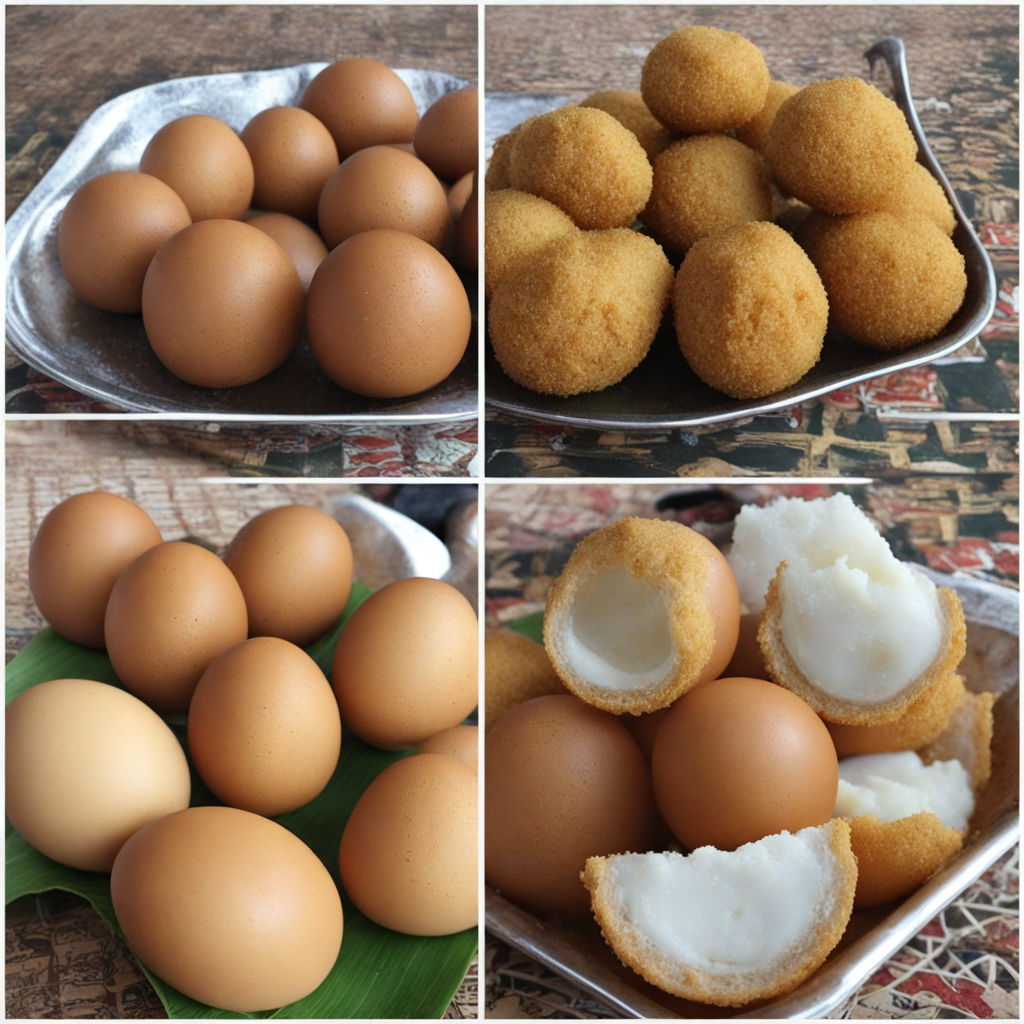Egg Ball
Egg Ball is a beloved street food originating from Guyana, showcasing the country's rich culinary heritage. At its core, this dish consists of hard-boiled eggs that are enveloped in a spiced potato mixture, creating a delightful contrast of textures. The outer layer is made from mashed potatoes mixed with seasonings like garlic, onions, and various spices, which provide a robust and aromatic flavor. This mixture is carefully molded around the egg, creating a satisfying bite that is both comforting and enticing. Once the egg is coated in the potato blend, it is rolled in breadcrumbs and deep-fried until golden brown, resulting in a crispy exterior that gives way to a creamy, savory center. The fusion of flavors is truly remarkable; the earthiness of the potatoes pairs beautifully with the rich, buttery taste of the egg. Often served as a snack or appetizer, Egg Balls can be enjoyed on their own or with a tangy dipping sauce that adds an extra layer of zest to the experience. Egg Balls not only reflect the diverse culinary influences of Guyana, but they also embody the spirit of communal eating, as they are frequently found at local markets and food stalls. With each bite, one can appreciate the harmonious blend of ingredients, showcasing the creativity and resourcefulness of Guyanese cuisine. This dish is a testament to the country's love for bold flavors and comforting food, making it a must-try for anyone looking to explore new tastes.
How It Became This Dish
The History of Egg Ball in Guyana Egg Ball, a beloved snack in Guyana, exemplifies the rich tapestry of culinary traditions woven together by the country’s diverse population. This delicious, deep-fried ball made primarily from mashed eggs, flour, and a medley of spices, has roots that reflect the historical migrations and cultural exchanges that have shaped Guyana. #### Origins To understand the origins of Egg Ball, one must first delve into the history of Guyana itself. This South American country, bordered by the Atlantic Ocean to the north, is distinguished by its colonial past and multi-ethnic society. The indigenous peoples, African slaves, East Indian indentured laborers, Chinese immigrants, and Portuguese settlers all contributed to the cultural fabric that defines Guyanese identity today. Egg Ball is thought to have emerged as a popular street food in the 20th century, particularly among the Indo-Guyanese community. The use of eggs in various forms can be traced back to traditional Indian cuisine, where they often serve as a key protein source. With the arrival of East Indian laborers in the 1830s, many culinary traditions were brought over, leading to the fusion of flavors and techniques that characterize modern Guyanese cuisine. As the dish evolved, it embraced additional influences from the African, Chinese, and Amerindian populations, resulting in a unique blend of spices and cooking methods. The incorporation of local ingredients and spices, such as garlic, onions, and pepper, began to define the flavors of Egg Ball, allowing it to resonate with a broader audience beyond its Indian roots. #### Cultural Significance Egg Ball is more than just a snack; it serves as a cultural symbol and a reflection of Guyana's communal spirit. Often found in markets and food stalls, Egg Balls are a staple during festive occasions and everyday gatherings alike. The dish is commonly enjoyed as a street food, appealing to locals and tourists who seek a taste of authentic Guyanese flavors. In many ways, Egg Ball embodies the spirit of sharing and hospitality that is central to Guyanese culture. It is a dish that is often shared among friends and family, embodying the warmth of communal dining. Additionally, Egg Balls are often served at celebrations ranging from birthdays to holiday feasts, making them a cherished part of Guyanese culinary heritage. Moreover, Egg Balls have become a symbol of resilience and adaptation. As migrants settled in various parts of the world, they carried their culinary traditions with them, allowing dishes like Egg Ball to evolve further. Today, they can be found in Caribbean communities abroad, serving as a reminder of home for many Guyanese expatriates. #### Development Over Time The development of Egg Ball over time has been a fascinating journey, marked by innovation and adaptation. Initially, the dish was quite simple, consisting primarily of mashed boiled eggs mixed with flour, salt, and pepper. As culinary techniques and ingredients became more accessible, the recipe began to incorporate a variety of spices and fillings. In the 1970s and 1980s, as Guyana experienced economic challenges and increased emigration, Egg Ball saw a resurgence in popularity. Street vendors became the face of this snack, selling it in busy markets and along bustling streets. The simplicity of the dish allowed it to thrive during tough times, providing an affordable option for many. During this period, Egg Balls also began to feature various fillings, such as spiced potatoes, fish, and even meat. This adaptability allowed the dish to cater to different tastes and dietary preferences, further embedding it into the fabric of Guyanese cuisine. The use of fresh, local ingredients not only enhanced the flavor but also supported local farmers and markets. As globalization took hold in the late 20th and early 21st centuries, Egg Ball became a culinary ambassador for Guyana. Food festivals, cultural events, and Caribbean-themed gatherings around the world began to showcase Egg Balls, allowing them to gain recognition beyond the borders of Guyana. Chefs and home cooks alike started experimenting with creative variations, introducing new ingredients while still honoring the traditional recipe. The internet and social media played a critical role in this culinary expansion. Food bloggers and influencers began highlighting Guyanese dishes, including Egg Balls, bringing them to a global audience. Recipes and cooking videos shared online led to a revival of interest in traditional Guyanese cuisine, inspiring a new generation of chefs to explore their roots and innovate on classic dishes. #### The Future of Egg Ball As Egg Ball continues to evolve, its essence remains rooted in the culture and history of Guyana. The dish has become a canvas for culinary experimentation, with chefs and home cooks adding their unique twists while maintaining the core components that make it beloved. The growing interest in global cuisine has led to an increased appreciation for Guyanese food, and Egg Ball is often a gateway for those unfamiliar with the culinary traditions of the region. Cooking classes, food tours, and culinary events centered around Guyanese cuisine are becoming more popular, ensuring that dishes like Egg Ball are passed down to future generations. Moreover, the rise of the diaspora community has created opportunities for Guyanese cuisine, including Egg Ball, to thrive in new locales. Food trucks and pop-up restaurants featuring Guyanese dishes are appearing in cities around the world, allowing expatriates to reconnect with their culinary heritage while introducing new audiences to the flavors of Guyana. #### Conclusion Egg Ball is more than just a dish; it is a vibrant representation of Guyana's rich history and cultural diversity. From its humble beginnings as a street food among the Indo-Guyanese community to its status as a cherished snack enjoyed by many, Egg Ball has navigated the currents of time with grace and resilience. As it continues to evolve and adapt, it remains a delicious reminder of the interconnectedness of food, culture, and identity in the beautiful mosaic that is Guyana.
You may like
Discover local flavors from Guyana







